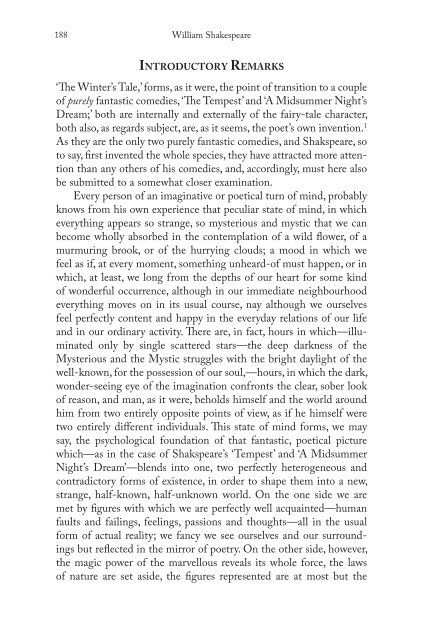Blooms Literary Themes - THE TRICKSTER.pdf - ymerleksi - home
Blooms Literary Themes - THE TRICKSTER.pdf - ymerleksi - home
Blooms Literary Themes - THE TRICKSTER.pdf - ymerleksi - home
Create successful ePaper yourself
Turn your PDF publications into a flip-book with our unique Google optimized e-Paper software.
188<br />
William Shakespeare<br />
introduCtory remarks<br />
‘The Winter’s Tale,’ forms, as it were, the point of transition to a couple<br />
of purely fantastic comedies, ‘The Tempest’ and ‘A Midsummer Night’s<br />
Dream;’ both are internally and externally of the fairy-tale character,<br />
both also, as regards subject, are, as it seems, the poet’s own invention. 1<br />
As they are the only two purely fantastic comedies, and Shakspeare, so<br />
to say, first invented the whole species, they have attracted more attention<br />
than any others of his comedies, and, accordingly, must here also<br />
be submitted to a somewhat closer examination.<br />
Every person of an imaginative or poetical turn of mind, probably<br />
knows from his own experience that peculiar state of mind, in which<br />
everything appears so strange, so mysterious and mystic that we can<br />
become wholly absorbed in the contemplation of a wild flower, of a<br />
murmuring brook, or of the hurrying clouds; a mood in which we<br />
feel as if, at every moment, something unheard-of must happen, or in<br />
which, at least, we long from the depths of our heart for some kind<br />
of wonderful occurrence, although in our immediate neighbourhood<br />
everything moves on in its usual course, nay although we ourselves<br />
feel perfectly content and happy in the everyday relations of our life<br />
and in our ordinary activity. There are, in fact, hours in which—illuminated<br />
only by single scattered stars—the deep darkness of the<br />
Mysterious and the Mystic struggles with the bright daylight of the<br />
well-known, for the possession of our soul,—hours, in which the dark,<br />
wonder-seeing eye of the imagination confronts the clear, sober look<br />
of reason, and man, as it were, beholds himself and the world around<br />
him from two entirely opposite points of view, as if he himself were<br />
two entirely different individuals. This state of mind forms, we may<br />
say, the psychological foundation of that fantastic, poetical picture<br />
which—as in the case of Shakspeare’s ‘Tempest’ and ‘A Midsummer<br />
Night’s Dream’—blends into one, two perfectly heterogeneous and<br />
contradictory forms of existence, in order to shape them into a new,<br />
strange, half-known, half-unknown world. On the one side we are<br />
met by figures with which we are perfectly well acquainted—human<br />
faults and failings, feelings, passions and thoughts—all in the usual<br />
form of actual reality; we fancy we see ourselves and our surroundings<br />
but reflected in the mirror of poetry. On the other side, however,<br />
the magic power of the marvellous reveals its whole force, the laws<br />
of nature are set aside, the figures represented are at most but the

















